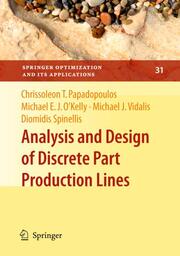Detailansicht
Analysis and Design of Discrete Part Production Lines
Springer Optimization and Its Applications 31
Papadopoulos, Chrissoleon T/O'Kelly, Michael E J/Vidalis, Michael J et
ISBN/EAN: 9780387894935
Umbreit-Nr.: 1076669
Sprache:
Englisch
Umfang: xx, 279 S., 95 s/w Illustr., 18 farbige Illustr.,
Format in cm:
Einband:
gebundenes Buch
Erschienen am 10.06.2009
Auflage: 1/2009
- Zusatztext
- InhaltsangabePreface.- 1 Manufacturing Systems: Types and Modeling.- 1.1 Manufacturing Systems: Evolution and Classification.- 1.2 Models and Modeling.- 1.3 Classification of Manufacturing Systems.- 1.4 Models of Manufacturing Systems.- 1.5 Methods of Analysis.- 1.6 Measures of Performance.- 1.7 Related Bibliography.- 2 Evaluative Models of Discrete Part Production Lines.- 2.1 Markovian Model.- 2.2 Decomposition Approach.- 2.3 The Expansion Method.- 2.4 The Aggregation Method.- 2.5 Modeling of Production Lines with Parallel Reliable Machines at each Station.- 2.6 Simulation Modeling.- 2.7 General Comment.- 2.8 Related Bibliography.- 3 The Design of Production Lines.- 3.1 Introduction.- 3.2 Role of the Design Engineer.- 3.3 Improvability.- 4 WorkLoad and Server Allocation Problems. 4.1 The WorkLoad Allocation Problem. 4.2 The Server Allocation Problem. 4.3 The SimultaneousWorkLoad and Server Allocation: The Lphenomenon. 4.4 Related Bibliography. 5 The Buffer Allocation Problem.- 5.1 Formulation of the Buffer Allocation Problems.- 5.2 Solution of the Buffer Allocation Problems.- 5.3 Solution Approaches to the BAP in Short Lines.- 5.4 Solution Approaches to the BAP in Longer Lines.- 5.5 Related Bibliography.- 6 Double and Triple Optimization.- 6.1 Simultaneous Allocation of Work and Buffers, W+B.- 6.2 Simultaneous Allocation of Servers and Buffers, S+B.- 6.3 Simultaneous Allocation of Work, Servers and Buffers, W+S+B.- 6.4 Related Bibliography.- 7 Cost Considerations.- 7.1 Cost Models - Profit Maximization.- 7.2 Cost Models - Cost Minimization.- A Mathematical Fundamentals.- A.1 Vectors and Matrices.- A.2 Probability.- A.3 Discrete Markov Processes (Markov Chains).- A.4 Data Plotting.- A.5 Well-Known Results of Queueing Theory.- B Algorithms/Procedures Details and Guide to Use.- B.1 Markovian.- B.2 Decomposition-1.- B.3 Expansion.- B.4 Aggregation.- B.5 Decomposition-2.- B.6 Two-level Work-Load Allocation.- B.7 Simulated Annealing.- B.8Genetic Algorithm.- B.9 Complete Enumeration.- B.10 Buffer Allocation.- C Glossary. C.1 General Acronyms. C.2 Production Lines. C.3 Decomposition Approach. C.4 Markovian Model. C.5 Expansion Method. C.6 Aggregation Method.C.7 Design Problems. C.8 Cost Considerations. C.9 Mathematical Fundamentals. C.10 Accompanying Algorithms/Procedures. D Conference Participants: Presenters and Attendees.- D.1 Conference Participants - Presenters.- D.2 Conference Participants - Attendees.- E Simulation Model of a Reliable Production Line.- E.1 Description of the Production Line.- E.2 The Model of the System.
- Kurztext
- Analysis and Design of Discrete Part Production Lines provides a complete overview of production systems, investigating several production line problems, and describing the best approaches to the analysis of production line performance. Written by experts in the field of production and manufacturing research, this book also presents numerous techniques that can be used to describe and model various types of production lines. Special Features: * Includes access to a supplementary web-based software package, providing algorithms and examples, developed by distinguished experts of the field. * Describes new results for evaluative techniques and design algorithms as well as several open problems in production line optimization. * Presents in detail the theory and techniques that underlie production system management, design, and analysis, allowing the book to serve as an excellent introduction to newcomers in the field. * Has potential for use in a graduate level course in industrial or manufacturing engineering, or in a business course with a manufacturing focus. * Contains appendices providing an overview of several mathematical techniques employed to design and evaluate production line models. This book is intended for researchers, production managers, and graduate students in industrial, mechanical, and systems engineering. Using the resources presented, consultants, engineers, and researchers will be able to design, evaluate, determine the behavior, and optimize the performance of both new and existing production lines.
